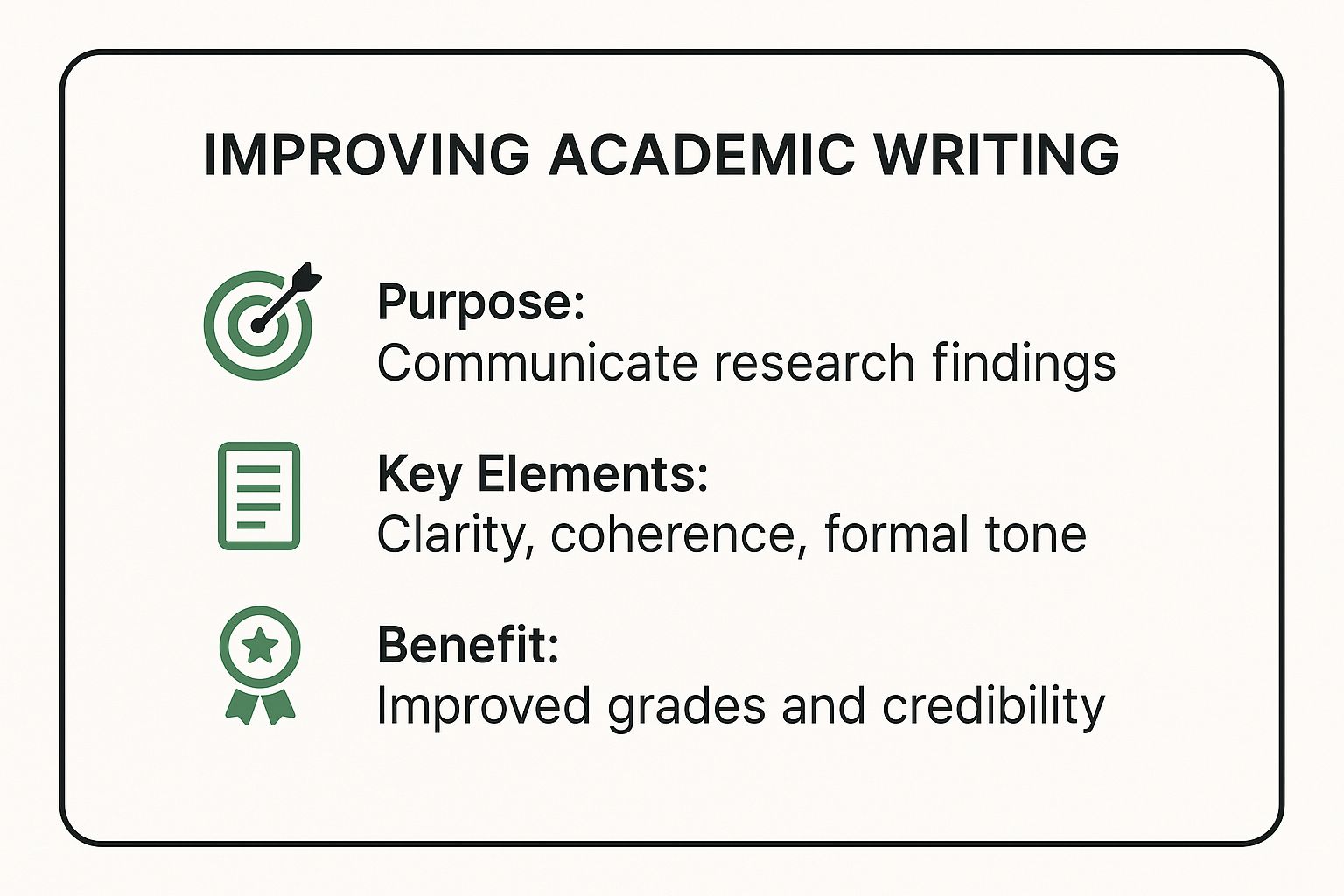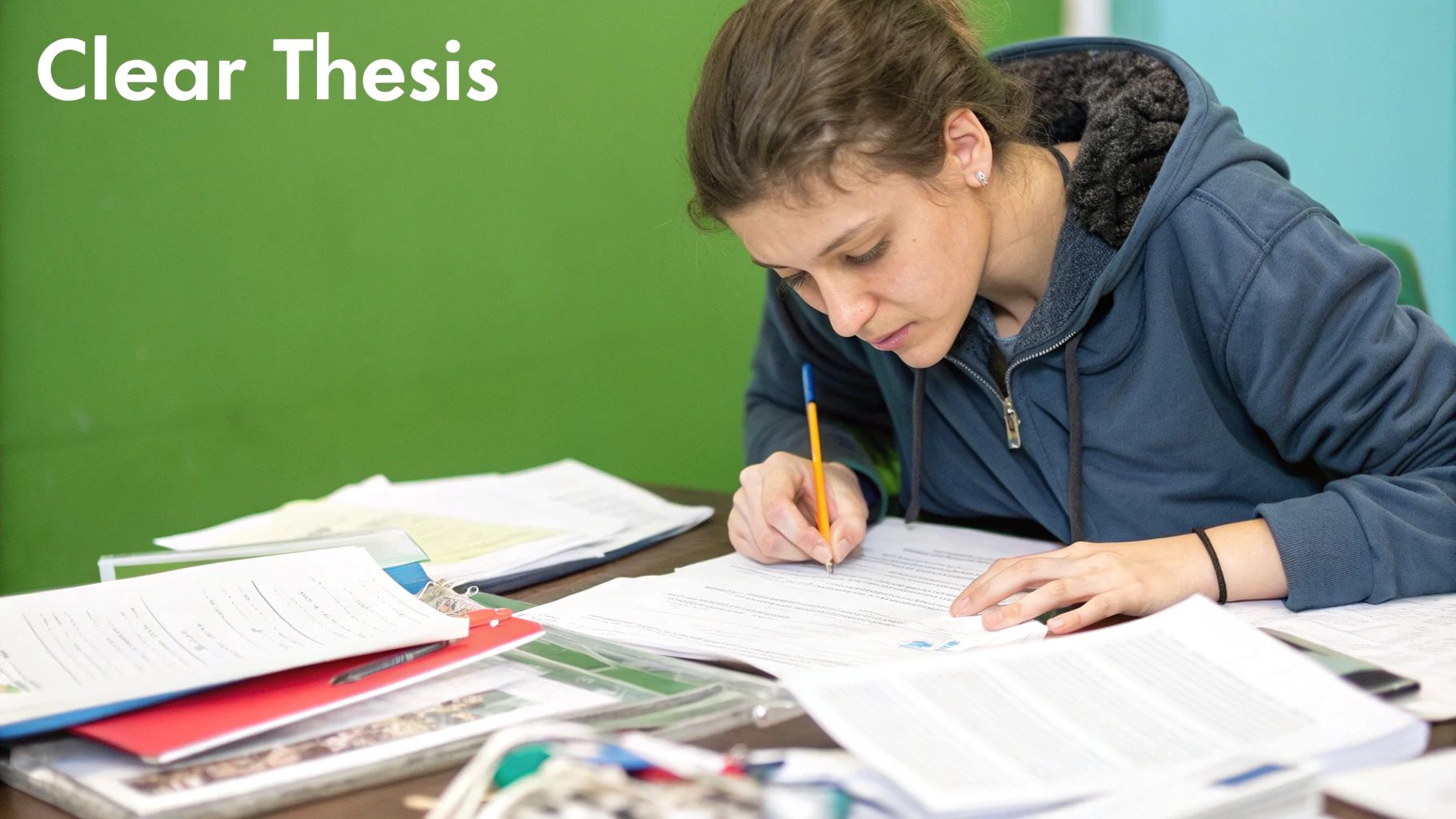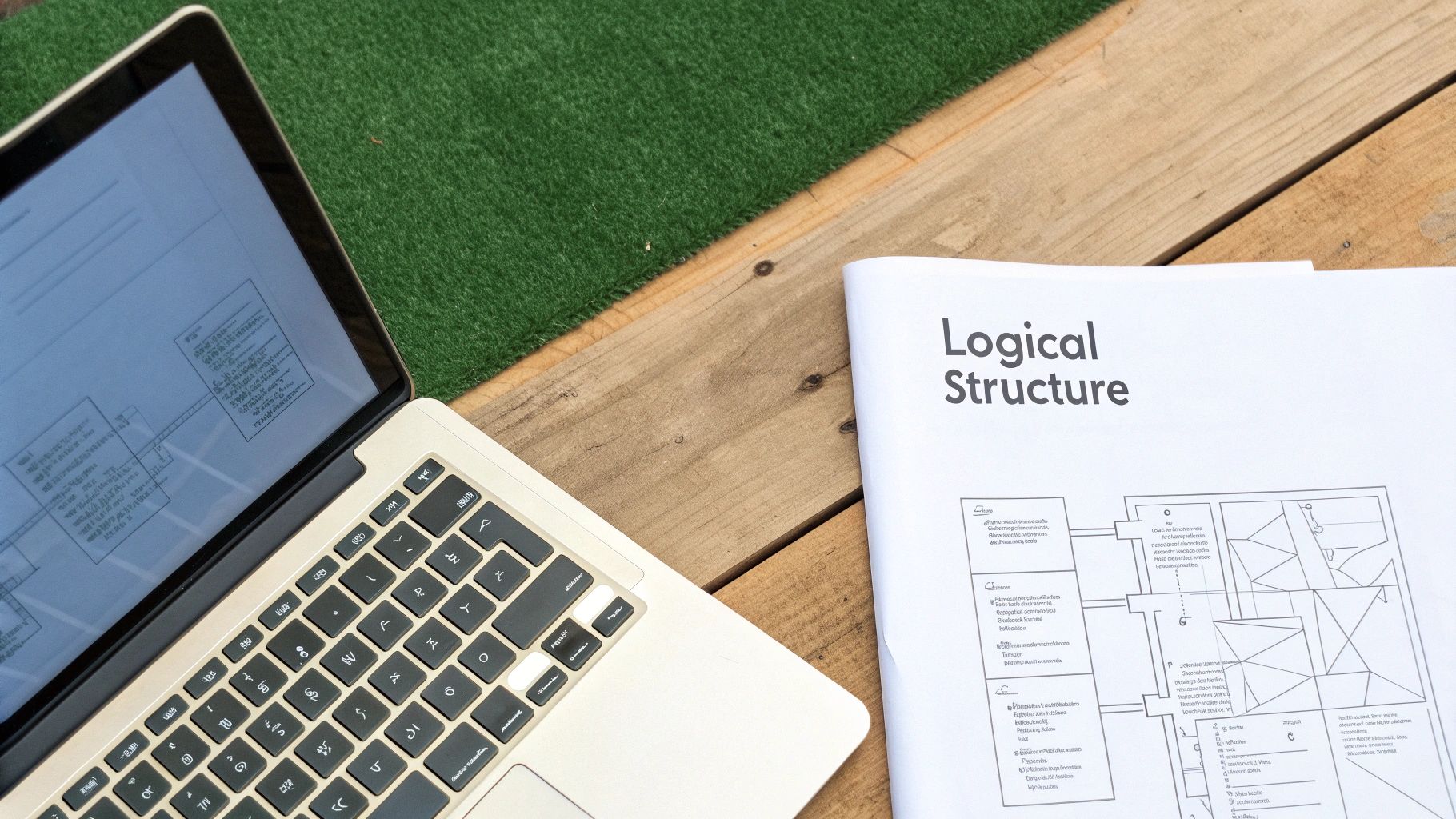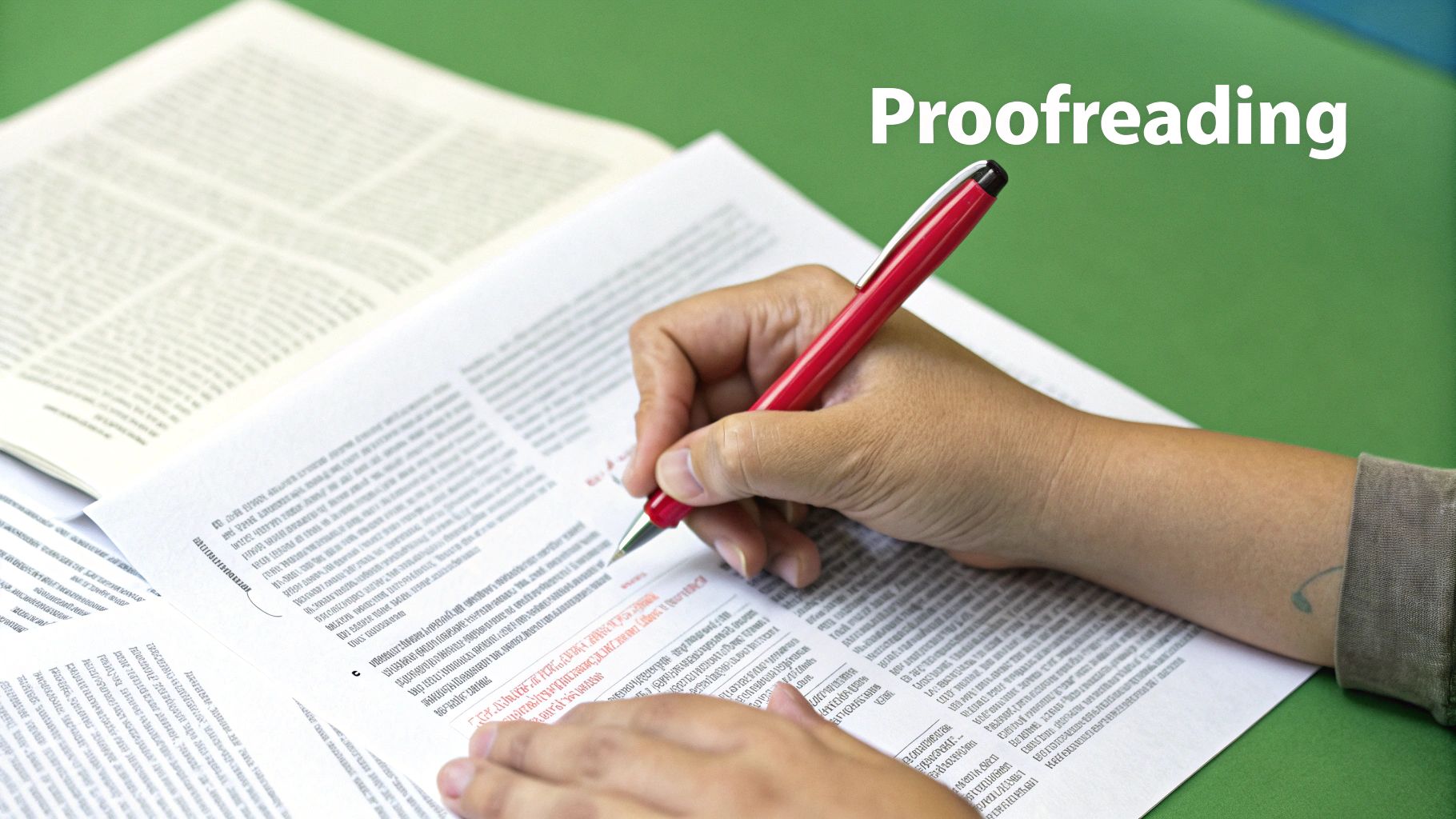
Improve Academic Writing From First Draft to Final Paper
June 30, 2025
To get better at academic writing, you need to make a fundamental shift in your thinking. It's not just about sharing information anymore. The real goal is to build a convincing, well-supported argument.
This means getting good at a few specific things: nailing down a clear thesis statement, organizing your ideas in a logical and coherent way, and writing with a formal, objective tone. You're moving from being a reporter of facts to becoming a respected scholarly voice.
Building a Strong Foundation for Your Academic Paper
The secret to powerful academic writing isn't hiding in fancy words or complicated sentences. It’s all about the foundation. To turn a simple report into a compelling argument, you have to do more than just list what you've learned. The work starts with a sharp, focused thesis statement that acts as the North Star for your entire paper, guiding every single paragraph and claim you make.
When you master this foundational stage, you’re taking the first real step toward producing work that people take seriously. It’s like giving your reader a clear blueprint so they can follow your logic from one point to the next without getting lost.
This infographic breaks down what that foundation looks like in practice.

As you can see, good academic writing is a balancing act. It needs a clear purpose, essential elements like coherence, and the ultimate goal of establishing your credibility as a researcher.
Clarify Your Core Argument First
Before you even think about writing your introduction, you need to know exactly what you're arguing. A vague idea like "I'm writing about climate change" is a recipe for a rambling, unfocused paper.
A strong argument, on the other hand, is specific and debatable. For instance, instead of the broad topic, you might land on: "This paper argues that local community-led conservation efforts are more effective at preserving biodiversity than top-down government policies." See the difference? Now you have a clear purpose to anchor you. Every piece of evidence and every source you cite must directly support this central claim.
A classic mistake I see all the time is students starting to write without a clear thesis, just hoping the argument will magically appear. It almost never does. This approach usually leads to a paper that wanders aimlessly. Your thesis is the promise you make to your reader; the rest of your paper is you keeping that promise.
This focus on argumentative writing isn't just a random classroom rule; it's a huge emphasis in higher education. A recent bibliometric analysis showed that between 2014 and 2023, argumentative writing skills were a top research priority, with the United States and institutions like Arizona State University leading the way.
To give you a quick reference, here are the core elements that every strong academic paper needs.
Core Elements of Strong Academic Writing
| Element | Description | Why It Matters |
|---|---|---|
| Clear Thesis | A single, debatable sentence that states your main argument. | It provides focus and direction for the entire paper, for both you and your reader. |
| Logical Structure | The organization of your ideas into a coherent flow (intro, body, conclusion). | A good structure makes your argument easy to follow and more persuasive. |
| Evidence-Based | All claims are supported by credible sources, data, or research. | It builds your credibility and demonstrates you've engaged with the topic seriously. |
| Objective Tone | Formal, unbiased language that avoids personal feelings or casual slang. | An objective tone establishes authority and shows respect for the academic context. |
| Coherence | Ideas are connected smoothly using transitions and clear topic sentences. | It prevents the paper from feeling like a list of disconnected facts. |
Getting these pillars right is more than half the battle. They provide the framework that holds your entire argument together.
Structure Your Paper for Maximum Impact
Once you've locked in a strong thesis, your next job is to structure the paper logically. Think of yourself as a guide leading your reader on a journey. Each section and paragraph is a signpost, moving them smoothly toward your conclusion.
A simple outline is a surprisingly powerful tool here. It doesn't need to be super detailed, but it should map out the key points for each section.
- Introduction: This is where you state your thesis and give a brief preview of the main points you'll cover.
- Body Paragraphs: Dedicate each paragraph to a single supporting idea. Always start with a topic sentence that clearly links back to your main thesis.
- Conclusion: Time to wrap things up. Summarize your argument, restate your thesis in a new way, and maybe touch on the broader implications of your findings.
This structured approach doesn't just help your reader; it forces you to think critically about how your ideas connect. For a deeper dive into the specific rules and formats, our complete academic writing style guide is a great resource. Following these established conventions is a key part of making sure your work is taken seriously.
Fine-Tuning Your Prose for Clarity and Precision

Academic writing walks a tightrope. It needs to be formal without being stuffy, and authoritative without being dense. Polishing your language is where your argument really starts to pop. This isn't about flexing your vocabulary with the biggest words; it's about picking the right words and arranging them so complex ideas flow with simple grace.
The real goal is to get your writing from just "correct" to something truly precise, concise, and compelling. This refinement is what makes your arguments not just understandable, but memorable.
Precision Over Jargon
Every field has its own terminology, and using it is often essential. But a classic mistake is drowning your sentences in so much jargon that the meaning gets lost. The best academic writers don't use big words to sound smart—they use precise language to make complicated things easy to grasp.
Think of it this way: you want to be a surgeon with a scalpel, not a brute with a sledgehammer. Each word should have a specific job.
- Vague: The results were kind of significant.
- Precise: The results showed a statistically significant correlation (p < .05).
That small shift from "kind of" to a specific statistical measure adds instant authority. It leaves zero room for misinterpretation. As you write, keep asking yourself: "Can I say this more directly?"
Embrace the Active Voice
Want a quick way to make your writing stronger? Use the active voice. It's more direct, more dynamic, and it makes your claims sound much more confident. The active voice clearly states who is doing what, which is exactly what you want when presenting your research.
It just hits differently.
- Passive: The experiment was conducted by the research team.
- Active: The research team conducted the experiment.
The active version is shorter and punchier. It puts the research team front and center, taking clear ownership of the action. While the passive voice has its place (like when the action is more important than who did it), overusing it makes your writing feel timid.
A little trick I learned is to do a "find and replace" search for the word "by" when I'm editing. It's a dead giveaway for passive voice. Flipping those sentences around instantly tightens up the whole paper.
Trim the Fat: The Art of Being Concise
Concise writing is powerful writing. Period. Every word on the page should be pulling its weight. Fluffy phrases, redundant words, and winding sentences just dilute your message and tire out your reader.
Be on the lookout for clutter. It’s everywhere.
in order tocan almost always be justto.due to the fact thatis a long-winded way to saybecause.at this point in timeis justnow.
Here's what that looks like in the wild:
- Wordy: It is important to note that the data, for all intents and purposes, suggests that there is a possibility that the hypothesis may be correct. (27 words)
- Concise: The data suggests the hypothesis may be correct. (8 words)
See the difference? The second version is sharp, direct, and respects your reader’s intelligence. Forcing yourself to be concise also forces you to clarify your own thinking. If you want more general tips, our guide on how to improve writing has a ton of great advice that applies to any context.
Eliminate Ambiguity at All Costs
Finally, your writing must be unambiguous. Your reader should never have to guess what you mean. Ambiguity loves to sneak in through vague pronouns or clunky sentence structures.
For example: "The researchers interviewed the participants in their homes."
Whose homes? The researchers' or the participants'? It’s not clear.
You have to spell it out.
- Better: The researchers interviewed participants in the participants' homes.
- Even Better: The researchers conducted interviews in the participants' homes.
This level of exactness isn't optional in scholarly work. When you proofread, pretend you know nothing about your topic. If any phrase could possibly be read two ways, rewrite it. That meticulous attention to detail is what separates the good from the great.
Weaving Sources into a Powerful Argument

Great academic papers don’t just list sources—they create a dialogue with them. I've seen countless students struggle with this, but mastering this conversation is a massive leap forward in your academic writing journey. It’s about critically engaging with the literature and blending different viewpoints to bolster your own unique thesis, not just summarizing what others have already said.
The real goal is to shift from being a spectator in the scholarly conversation to becoming an active, respected contributor. This means every source you use has a clear purpose, whether you're paraphrasing it ethically or dropping in a direct quote for that perfect punch.
Moving Beyond the Literature Dump
One of the most common mistakes I see is the "literature dump." This is where a paper just presents a string of summaries: "Author A said this," followed by, "Author B found that." This approach falls flat because it doesn't build an argument. It just gives the reader a list.
Your job as a scholar is to be the guide. You're the one interpreting and connecting these different sources for your reader.
Instead of just reporting, you need to synthesize. This means you’re on the lookout for patterns, agreements, and even disagreements among your sources. Start asking yourself the right questions:
- How does Author B’s research challenge or build on what Author A found?
- When I look at these sources together, do they point to a bigger trend or an unanswered question?
- Where does my own research fit into this whole conversation?
Your voice should always be the one in control of the narrative. You’re using the evidence from others to construct your own compelling case.
Finding Your Niche in the Scholarly Conversation
A powerful way to think about your contribution is to stop trying to "fill a gap" and start thinking about "carving out a space." This subtle shift in mindset, inspired by scholars like Dr. Raul Pacheco-Vega, moves you away from a combative style of research. Instead of trying to prove everyone else wrong, you focus on adding a fresh perspective.
This is a much more constructive way to approach originality. You could be:
- Extending an existing theory by applying it to a brand-new case study.
- Combining two different frameworks to look at a problem in a way no one has before.
- Adding another analytical lens to a topic that’s already been heavily researched.
This approach honors the fact that you're building on the work of others, which strengthens everyone's collective understanding.
"The core element in this discussion, I believe, is how we need to rethink theoretical and empirical contributions (which can and definitely will be, most of the time, incremental) as 'adding to the conversation, building on previous work, extending, taking an idea further.'"
This mindset helps you position your work thoughtfully. It makes your contribution clear and meaningful without feeling like you have to claim you've discovered something completely unheard of.
Paraphrasing with Purpose
Paraphrasing is so much more than just swapping out a few words. Ethical paraphrasing means you have to fully digest an author's idea and then re-explain it entirely in your own words and sentence structure—while still giving them proper credit, of course. It’s proof that you genuinely understand the material.
When you paraphrase, you should also be analyzing. Don't just restate the idea. Explain why it matters to your argument. For instance, after you paraphrase a key finding, you could add, "This finding is crucial because it directly challenges the long-held assumption that..." See how that connects the source right back to your own thesis?
Mastering these skills is a real challenge, and it's one reason the market for academic support has exploded. A 2023 analysis valued the global essay writing service market at about USD 1.97 billion, with projections to hit USD 4.35 billion by 2032. That demand highlights the pressure students feel to produce top-tier work. You can explore more about these market trends and what’s driving them.
Using Direct Quotes for Maximum Impact
While paraphrasing should be your go-to move, direct quotes have their own special role. They're most effective when you use them sparingly and strategically. Save them for those moments when:
- The author's original phrasing is just too powerful, precise, or memorable to change.
- You need to analyze the specific wording of a source.
- The quote is from a major authority whose exact words add serious weight to your point.
But never, ever let a quote stand on its own. Always introduce it with some context, and then follow it up with your own analysis explaining why it's so important. Think of it as a "quote sandwich"—introduction, quote, analysis. This ensures the quote is serving your argument, not the other way around.
Using Technology and AI to Sharpen Your Writing
Let's be honest: modern tools can be a writer's best friend, but only if you know how to use them well. The right tech can sharpen your academic prose, catch sneaky errors you’ve stared at for hours, and take the tedium out of formatting.
The secret is to treat these tools as assistants—ones that boost your skills, not replace your own critical thinking. They’re here to make your drafting and revision process smarter, not to do the work for you.
Smart Assistants for Drafting and Editing
AI-powered writing assistants have come a long way from being simple grammar checkers. They’re now surprisingly sophisticated partners in the writing process. Since 2023, these tools have become essential for getting real-time feedback on everything from grammar to coherence, which is a huge help when you're trying to improve your writing or just get past writer's block. For a deeper look, you can discover insights on the future of academic writing.
Tools like Grammarly, ProWritingAid, and even the editor in Microsoft Word have gotten much smarter. They can now help you:
- Spot tricky grammar issues: They go beyond typos to flag complex problems like faulty parallel structure or dangling modifiers.
- Improve your style: These tools can help you maintain a consistent tone, find stronger words, and point out when you’re leaning too heavily on the passive voice.
- Boost clarity: They’re great at identifying wordy, confusing sentences and suggesting sharper, more concise alternatives.
Think of them as your first-pass editor. They create a valuable safety net, catching mechanical mistakes so you can focus on the big-picture stuff, like the strength of your argument.
Here’s a look at how a tool like Grammarly gives you live feedback. It highlights potential issues right in your text and offers clear, one-click fixes that actually help you learn.
Using AI Ethically and Effectively
While AI can draft text, its real power in academic work is for refinement and brainstorming. Handing in a paper written entirely by AI is a serious breach of academic integrity. But using it as a thinking partner? That's a smart strategy.
For instance, you could ask an AI to rephrase a clunky sentence or generate a list of counterarguments to your thesis. This keeps you in control. Remember, AI-generated text often lacks nuance and can sound incredibly generic. It's on you to refine and personalize anything it produces. If you want to make AI content sound more like you, our guide offers practical tips on how to humanize AI-generated text.
The goal is to use AI to augment your intelligence, not replace it. It should be a tool that helps you think more deeply, spot blind spots, and explore new ways to express your ideas. It should never be the final author.
Master Your Citations with Reference Managers
If there's one task that drains the soul of an academic writer, it's managing citations. This is where reference management software becomes a lifesaver. Tools like Zotero, Mendeley, and EndNote are absolute game-changers.
With these tools, you can:
- Organize all your research: Keep every source in one searchable library, complete with your notes and attached PDFs.
- Automate citations instantly: Insert in-text citations and generate a perfectly formatted bibliography in seconds. APA, MLA, Chicago—you name it.
- Avoid frustrating errors: Manually creating citations is a recipe for mistakes. These tools ensure accuracy and consistency, saving you from losing marks on small details.
Seriously, invest a couple of hours into learning one of these programs. You’ll save yourself countless hours of frustration later. It automates a tedious task, freeing up your brainpower for the real work: crafting a compelling argument.
The Real Work Starts After the First Draft

Let's be honest: your first draft is just you getting your ideas down. The real magic—the part that turns a decent paper into a great one—happens during revision. This is where you get to fortify your arguments, tighten your prose, and really make your work shine.
Too many students think "editing" is just a quick spell-check before hitting submit. That's a mistake. True revision is a layered process. It's about stepping back, looking at your work with fresh eyes, and methodically moving from the big-picture structure down to the nitty-gritty of a single sentence.
A More Strategic Way to Revise
The biggest mistake I see is students trying to fix everything at once. They'll correct a typo in one sentence, then rethink an entire paragraph in the next. This approach is a recipe for overwhelm and missed errors.
A far better way is to work in passes, like a painter adding layers to a canvas. Think of it like using a camera: start with a wide-angle lens and slowly zoom in. You check the overall structure first, then zoom to the paragraph level, then to sentences, and finally, you pull out the microscope for individual words. This ensures you aren't wasting time polishing a paragraph that shouldn't even be there.
Here’s a practical way to break it down:
The Big Picture Pass: First, look at the skeleton of your paper. Is your main argument clear and consistent from start to finish? Does the structure flow logically, or do you need to move some sections around? Is your evidence actually strong enough to support your claims?
The Paragraph Pass: Next, zoom in on each paragraph. Does every paragraph have a clear topic sentence that anchors it? Does everything in that paragraph stick to that single idea? And, importantly, do you have smooth transitions that guide the reader from one paragraph to the next?
The Fine-Tuning Pass: This is the final polish. Read through for sentence clarity and conciseness—can you say the same thing in fewer words? Swap out weak or vague words for more precise academic language. This is also your final, dedicated proofread for typos and formatting issues.
Why You Can't Edit in a Vacuum
You will eventually become blind to your own mistakes. It’s inevitable. After spending hours with a paper, your brain starts to auto-correct errors and fill in logical gaps. That's why getting feedback from someone else isn't just helpful; it's essential.
I once worked with a graduate student who was convinced her dissertation chapter was perfect. After a peer review, she was floored to discover that her core argument—the one she thought was crystal clear—was completely confusing to her readers. The feedback was a tough pill to swallow, but it was exactly what she needed to turn a muddled draft into an award-winning paper.
"You can’t improve what you’ve written if you haven’t written anything." This simple quote gets to the heart of it. Revision and feedback are impossible without a draft to work with, no matter how messy it is.
How to Take Criticism Without Taking it Personally
Getting feedback can sting. It’s easy to feel like it’s a personal attack. But learning to process criticism is a critical academic skill. Remember, it’s not about you—it’s about making the work better.
Here’s how to handle it:
- Just Listen: Your first instinct might be to argue or get defensive. Resist it. Just listen, nod, and take detailed notes. Let the comments sink in before you decide how to act on them.
- Ask for Clarity: If a comment is vague, ask for specifics. "Can you show me an example of where my argument felt weak?" is far more productive than stewing in confusion.
- Look for Patterns: One person’s opinion might be an outlier. But if two or three people all flag the same issue, that’s a red flare. You need to address it.
- You're in the Driver's Seat: At the end of the day, it's your paper. You don't have to accept every single suggestion. Thank your reviewers for their time, then thoughtfully decide which changes truly serve your goals.
By embracing this cycle of revision and feedback, you're doing more than just completing an assignment. You're participating in the real work of academia: refining ideas through conversation. And that's a skill that will serve you long after you've left the classroom.
Your Top Academic Writing Questions, Answered
Navigating the world of academic writing can feel like trying to hit a moving target. The rules seem to shift, and just when you think you've got it down, a new question pops up. It’s completely normal.
Think of this section as a quick-reference guide for those moments of doubt. I’ve rounded up some of the most common—and persistent—questions I hear from students and researchers. Let's get them answered.
How Can I Make My Academic Writing Sound More Confident?
Real confidence in writing doesn’t come from using fifty-dollar words. It comes from clarity and conviction. You want your statements to be direct, well-supported, and impossible to misunderstand.
One of the fastest ways to project confidence is by using strong, precise verbs and sticking to the active voice. Instead of a passive phrase like, "The data was analyzed by the researchers," flip it. "The researchers analyzed the data." It's direct, it takes ownership, and it’s simply stronger writing.
Also, watch out for hedging. Phrases like "it seems that," "I feel," or "one might argue" can unintentionally weaken your claims. State your argument, then back it up with the evidence you've gathered. A well-structured paper, where your logic flows clearly from one point to the next, is a massive confidence booster on its own. It shows you're in complete control of the narrative.
What Is the Biggest Mistake to Avoid?
If I had to pick just one, it's this: treating the literature review like a laundry list of summaries. So many writers fall into the trap of just reporting what others have said: "Smith (2020) found this, and Jones (2022) found that." This isn't an argument; it's a book report.
Your job isn't to report—it's to synthesize. You need to show your reader how these sources talk to each other and, crucially, how they all connect back to your argument.
Your voice must be the one guiding the entire discussion. Think of sources as the evidence you use to build your case, not as a replacement for your own analysis. The conversation should be driven by your perspective, using the literature to support, challenge, or extend your points.
This is how you show you've truly engaged with the material. It moves you from being a passive observer to an active participant in the scholarly conversation.
How Long Should My Paragraphs Be?
There isn’t a magic number, but the best rule of thumb is to stick to one main idea per paragraph. That’s it. A paragraph should be long enough to introduce, develop, and support that single idea, but short enough to avoid becoming a giant wall of text.
As a general guideline, most academic paragraphs run between three and eight sentences, maybe 150 to 250 words. If you see a paragraph creeping past that, it’s a red flag. You've probably packed more than one core idea in there. Find a natural break and split it. Keeping your paragraphs focused makes your argument infinitely easier for a reader to follow.
Is It Okay to Use "I" in Academic Writing?
This is a classic, and the confusion is understandable. The old-school rule to never use "I" just doesn't apply everywhere anymore. The right answer really depends on your field.
- In the humanities and many social sciences, using the first person ("I argue that...") is now common and often encouraged. It makes your position clear and transparent.
- In most STEM fields, the tradition of using a more objective, third-person voice is still strong. The focus is meant to be on the research itself, not the researcher.
When in doubt, check the conventions of your discipline. The best way to do this is to look at recently published articles in the top journals for your field. See what they're doing. And if you're still not sure, the simplest solution is always the best: just ask your professor or supervisor.
Ready to transform your drafts from robotic to readable? Natural Write provides a free, secure platform to humanize AI-generated text, ensuring your writing is clear, natural, and passes AI detection with ease. Polish your next paper with confidence. Try it today at https://naturalwrite.com.


